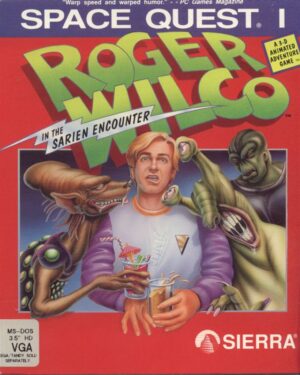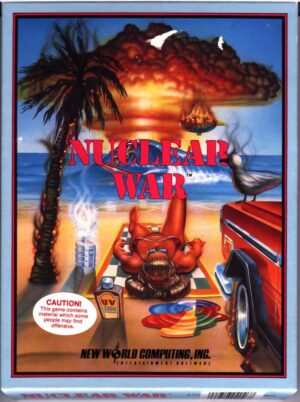Retro Replay Review
Gameplay
Bloodwych’s gameplay stands out as a classic homage to early dungeon-crawlers, offering real-time, first-person exploration through a maze-like environment. Movement is grid-based, with characters rotating and stepping forward tile by tile. This familiar structure provides tight control over your party’s positioning, creating both strategic depth in combat and a satisfying sense of discovery as you uncover hidden doors, secret passages, and puzzle‐locked rooms.
(HEY YOU!! We hope you enjoy! We try not to run ads. So basically, this is a very expensive hobby running this site. Please consider joining us for updates, forums, and more. Network w/ us to make some cash or friends while retro gaming, and you can win some free retro games for posting. Okay, carry on 👍)
One of Bloodwych’s most distinctive features is its two-player split-screen mode. Rather than simply trading turns, two players can simultaneously navigate separate views of the dungeon on a single monitor. Parties of up to four characters per player make for up to eight adventurers exploring Trazere in parallel. Cooperative tactics such as flanking enemies, coordinating spell combinations, and sharing treasure add a unique social dimension that few games of the era attempted, let alone executed so smoothly.
The class and spell systems deepen the core loop. You start with basic warrior, mage, adventurer, and thief roles, but as you advance you unlock colored subclasses—red, blue, green, and yellow—that modify your spells and stats. Spellcasting is both intuitive and strategic: you combine runes in your spellbook to cast healing, offensive blasts, or utility magics. This encourages experimentation, as mixing different colors can yield new and powerful effects, rewarding players who take time to learn the system.
Combat itself is adrenaline-fueled, with real-time melee clashes, ranged attacks, and spell duels against beasts and undead. Inventory management remains crucial—limited slots force tough choices about weapons, potions, and artifacts. Because the game rarely pauses, you must think on your feet, switching between party members, coordinating spells, and retreating when the odds turn against you. This intensity, combined with methodical exploration, gives Bloodwych a satisfying ebb and flow that keeps you invested session after session.
Graphics
By modern standards, Bloodwych’s graphics are understandably dated, but they possess a certain retro charm that fans of late-80s design will appreciate. The game uses simple textured walls and floor tiles, with sprite-based enemies and items that rotate to face the player. While lacking high-resolution detail, the contrasting colors and clear iconography ensure that vital information—enemy health, treasure chests, and directional cues—remains immediately readable.
Lighting effects are rudimentary but effective: torches cast warm glows on nearby walls, while deeper corridors remain ominously dark until you bring a light source. This creates real tension as you venture into unknown chambers, never knowing what lurks beyond the edge of your vision. The interface integrates health bars, spellbooks, and a mini-map overlay, balancing utility with immersion without cluttering the screen.
Enemy and character sprites, though limited in frame count, animate smoothly enough to convey motion and attack patterns. The color-coded subclasses extend to your party portraits, making it easy to track who’s wielding which spells or weapons at a glance. While you won’t find polygonal models or dynamic shadows here, the cohesive aesthetic and clear visual hierarchy suit Bloodwych’s focus on exploration and strategy rather than spectacle.
Story
The narrative premise of Bloodwych is straightforward yet engaging: you are the champion of Trazere, tasked with stopping Zendick’s betrayal of the mage order known as Bloodwych. Zendick, once second-in-command, has banished his rivals to the astral plane and plots to summon the Lord of Entropy, threatening the land’s fragile balance. This classic good-versus-evil setup provides clear motivation for your party’s dungeon delves and magical battles.
Bloodwych’s story unfolds gradually through scrolls, inscriptions, and conversations with freed Bloodwych mages. These fragments flesh out the world’s history—how the Grand Dragon guided the order, the fracture caused by ambition, and the hidden lore of elemental magic. While the plot doesn’t veer into complex political intrigue, its simplicity serves the gameplay, driving you deeper into Zendick’s lair with every artifact recovered and ally liberated.
Character dialogue remains minimal but functional, using brief lines to signal quest updates or to reveal secrets behind locked doors. The true narrative reward lies in exploration—each new chamber or astral rift unveils more context for Zendick’s madness and the sacrifices made by his opponents. For players who savor piecing together lore and triumphing over arcane challenges, Bloodwych’s story provides just enough backdrop to imbue every corridor with purpose.
Overall Experience
Bloodwych delivers a nostalgic, challenging dive into the foundations of first-person RPGs. Its combination of real-time combat, split-screen cooperative play, and flexible spell system offers depth rarely seen in its era. If you thrive on tactical decision-making—managing party resources, coordinating multiplayer strategies, and experimenting with colored spell combinations—you’ll find countless hours of compelling gameplay here.
The presentation may feel crude compared to today’s standards, but the atmosphere generated by flickering torches, echoing halls, and suspenseful silence is enduring. The UI strikes a fine balance between showing essential stats and leaving the screen uncluttered, so you remain fully immersed in Trazere’s dangerous labyrinths. Navigational aids such as automatically drawing maps are a welcome convenience that modern retro enthusiasts will appreciate.
While Bloodwych’s story doesn’t redefine narrative expectations, it establishes clear stakes and provides a satisfying sense of progression as you thwart Zendick’s plan. Freeing banished mages and recovering magical artifacts gradually turns the tide, culminating in a final confrontation that feels earned. Whether you’re revisiting this classic or discovering it for the first time, Bloodwych stands as a testament to the ingenuity of early dungeon-crawl design and remains a worthwhile purchase for fans of strategic, atmosphere-driven RPGs.
 Retro Replay Retro Replay gaming reviews, news, emulation, geek stuff and more!
Retro Replay Retro Replay gaming reviews, news, emulation, geek stuff and more!








Reviews
There are no reviews yet.